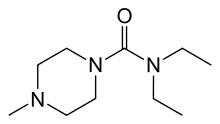Diethylcarbamazine
Diethylcarbamazine (DEC) is a medication used in the treatment of filariasis including lymphatic filariasis, tropical pulmonary eosinophilia, and loiasis.[1] It may also be used for prevention of loiasis in those at high risk.[1] While it has been used for onchocerciasis (river blindness), ivermectin is preferred.[2] It is taken by mouth.[3]
 | |
| Clinical data | |
|---|---|
| Other names | N, N-diethyl-4-methyl-1-piperazine carboxamide |
| AHFS/Drugs.com | Micromedex Detailed Consumer Information |
| Routes of administration | by mouth |
| ATC code | |
| Legal status | |
| Legal status |
|
| Identifiers | |
| |
| CAS Number | |
| PubChem CID | |
| DrugBank | |
| ChemSpider | |
| UNII | |
| KEGG | |
| ChEMBL | |
| CompTox Dashboard (EPA) | |
| ECHA InfoCard | 100.001.840 |
| Chemical and physical data | |
| Formula | C10H21N3O |
| Molar mass | 199.298 g·mol−1 |
| 3D model (JSmol) | |
| Melting point | 47 to 49 °C (117 to 120 °F) |
| |
| |
| (verify) | |
Common side effects include itching, facial swelling, headaches, and feeling tired.[4] Other side effects include vision loss and dizziness.[4] It is a recommended treatment in pregnancy and appears to be safe for the baby.[5][6] The World Health Organization; however, recommends waiting until after pregnancy for treatment when feasible.[2] It is made from 4-methyl-piperazine.[7]
Diethylcarbamazine was discovered in 1947.[8] It is on the World Health Organization's List of Essential Medicines.[9] It is not commercially available in the United States but can be acquired from the Centers for Disease Control and Prevention.[1]
Medical uses
DEC is indicated for treatment of individual patients with certain filarial diseases, including lymphatic filariasis caused by infection with Wuchereria bancrofti, Brugia malayi, or Brugia timori; tropical pulmonary eosinophilia; and loiasis.
In cases of onchocerciasis, another common filarial parasite, the drug is effective.
DEC continues to be the mainstay for treatment of patients with lymphatic filariasis and loiasis. DEC is also used to prevent heartworm in dogs.
Now, the WHO recommends prescribing DEC to patients who are infected with microfilariae of filarial parasites and also to control transmission of infection in filariasis-endemic areas.
Contraindications are previous history of heart problems, gastrointestinal problems, and allergies.
In India and China, diethylcarbamazine has been added to salt to combat lymphatic filariasis.[10]
Mechanism
DEC is an inhibitor of arachidonic acid metabolism in microfilariae. This makes the microfilariae more susceptible to innate immune attack, but does not kill the parasites outright.[11]
Trade names
- Hetrazan
- Carbilazine
- Caricide
- Cypip
- Ethodryl
- Notézine
- Spatonin
- Filaribits
- Banocide Forte
- Eofil
References
- "Our Formulary Infectious Diseases Laboratories CDC". www.cdc.gov. 22 September 2016. Archived from the original on 16 December 2016. Retrieved 7 December 2016.
- World Health Organization (2009). Stuart MC, Kouimtzi M, Hill SR (eds.). WHO Model Formulary 2008. World Health Organization. p. 91. hdl:10665/44053. ISBN 9789241547659.
- "Diethylcarbamazine Citrate". International Drug Price Indicator Guide. Retrieved 1 December 2016.
- "Diethylcarbamazine Advanced Patient Information - Drugs.com". www.drugs.com. Archived from the original on 20 December 2016. Retrieved 8 December 2016.
- Sweet, Richard L.; Gibbs, Ronald S. (2009). Infectious Diseases of the Female Genital Tract. Lippincott Williams & Wilkins. p. 382. ISBN 9780781778152. Archived from the original on 2017-09-10.
- Herbert-Ashton, Marilyn; Clarkson, Nancy Elaine (2005). Quick Look Nursing: Pharmacology. Jones & Bartlett Learning. p. 48. ISBN 9780763735951. Archived from the original on 2017-09-10.
- "WHO Model Prescribing Information: Drugs Used in Parasitic Diseases - Second Edition: Helminths: Lymphatic filariasis: Diethylcarbamazine". apps.who.int. 1995. p. 152. Archived from the original on 20 November 2016. Retrieved 8 December 2016.
- Busvine, James (2012). Disease Transmission by Insects: Its Discovery and 90 Years of Effort to Prevent it. Springer Science & Business Media. p. 260. ISBN 9783642457166. Archived from the original on 2017-09-10.
- World Health Organization (2019). World Health Organization model list of essential medicines: 21st list 2019. Geneva: World Health Organization. hdl:10665/325771. WHO/MVP/EMP/IAU/2019.06. License: CC BY-NC-SA 3.0 IGO.
- WHO: Unfulfilled potential: using diethylcarbamazine-fortified salt to eliminate lymphatic filariasis
- El-Shahawi, G. A.; Abdel-Latif, M; Saad, A. H.; Bahgat, M (2010). "Setaria equina: In vivo effect of diethylcarbamazine citrate on microfilariae in albino rats". Experimental Parasitology. 126 (4): 603–10. doi:10.1016/j.exppara.2010.06.022. PMID 20599991.
External links
- "Diethylcarbamazine". Drug Information Portal. U.S. National Library of Medicine.